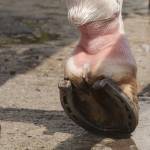Hoof Abscesses in Horses

You took your horse out for an easy trail ride on Monday and he seemed to be in good health. On Tuesday morning, he is desperately lame, unable to bear weight on one hoof and in obvious pain. What happened?
A hoof abscess is a likely culprit for sudden and severe lameness. An accumulation of pus within the hoof can cause intense pain because the swelling is trapped by the hard tissue of the sole and the pressure can’t be relieved. Abscesses quickly lead to lameness, making a horse three-legged literally overnight.
Infection within the hoof can occur when bacteria enter through a crack, puncture wound, or horseshoe nail driven too close to sensitive hoof tissue. Bruised soles sometimes lead to an abscess. In many cases, no entry point or wound is found.
Fortunately, it’s usually easy to diagnose a hoof abscess and allay the horse’s pain. A veterinarian can use hoof testers to locate the abscess. Cutting into the sole over the infection allows the pus to drain after which the horse is usually much more comfortable. A shoe with a pad may be used to keep dirt away from the sole until the cut heals. The veterinarian may prescribe antibiotics to clear up any lingering infection, though most routine hoof abscesses do not require antibiotics.
If a hoof abscess isn’t drained through a hole in the sole, the pus may work upward until it bursts out at the coronary band (gravel). This may also occur if the infection is located deeper in the hoof and can’t easily be drained by cutting into the sole.
Because there are several possible causes for sudden, severe lameness, a veterinarian should examine the horse to rule out laminitis, fractures, or other problems. If the veterinarian determines that the lameness is due to an abscess, he can treat the horse, possibly with the assistance of a farrier.








